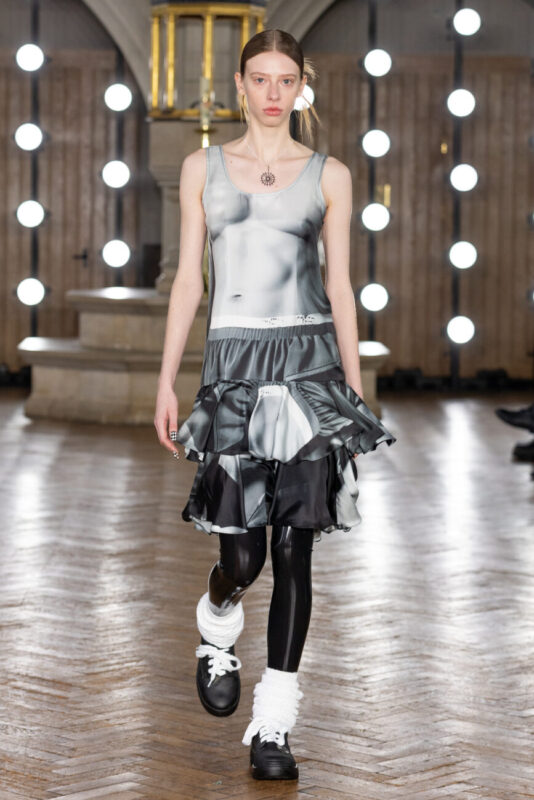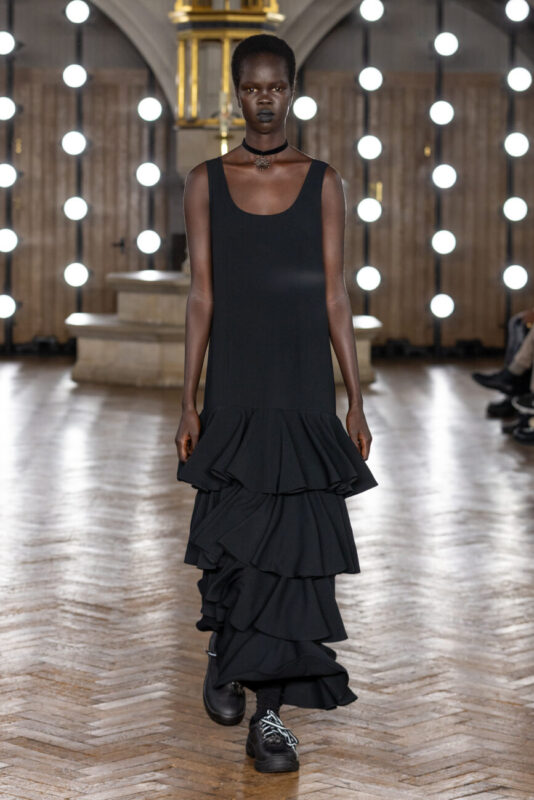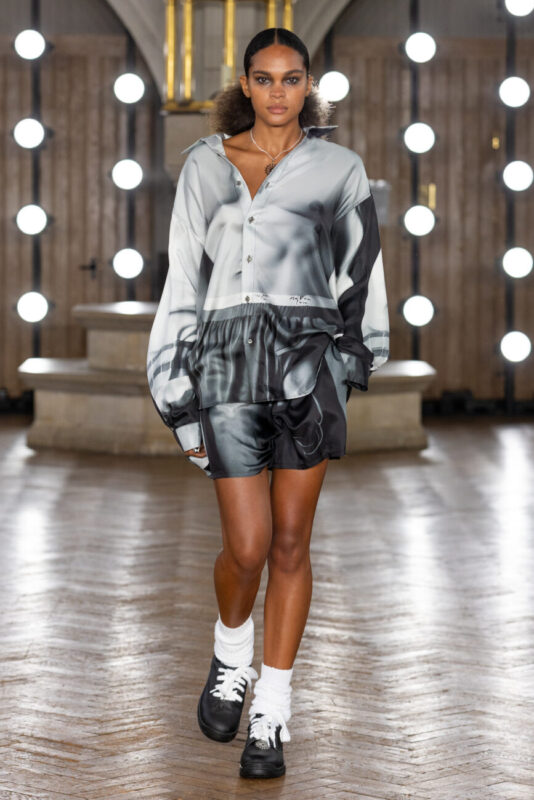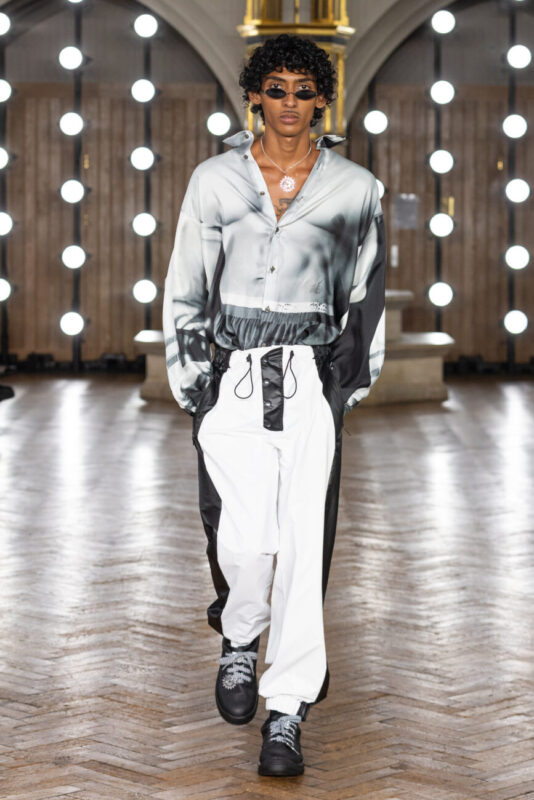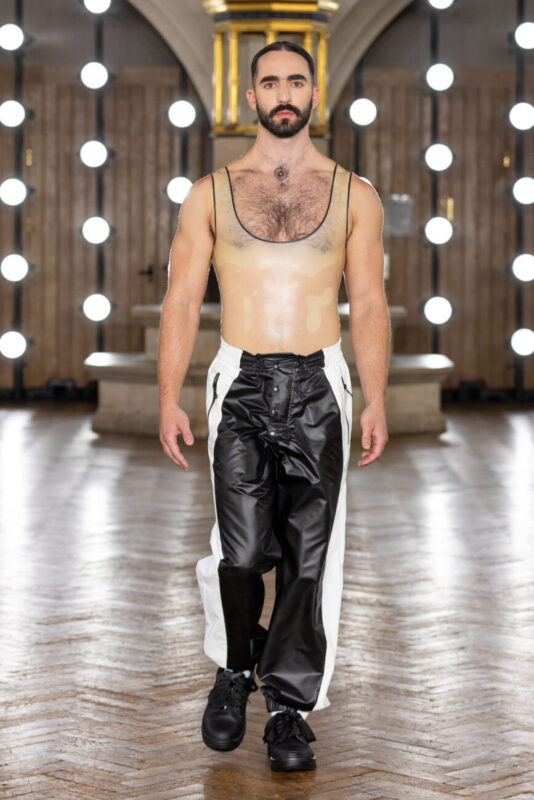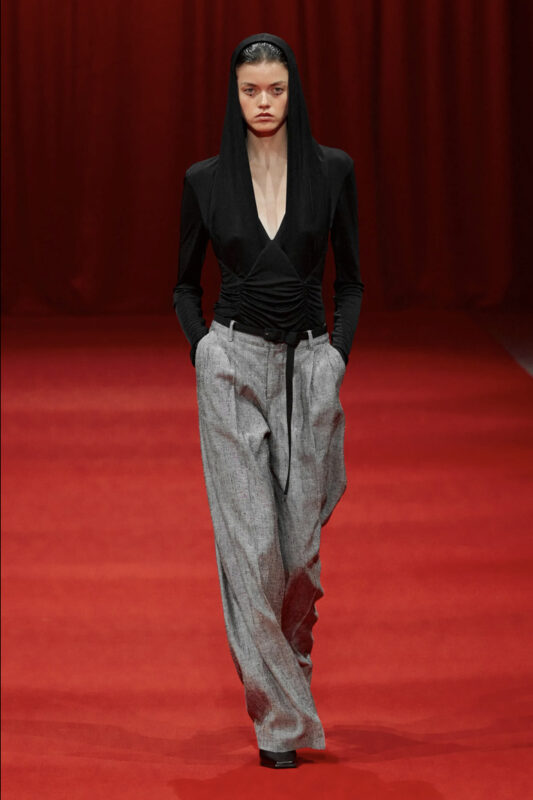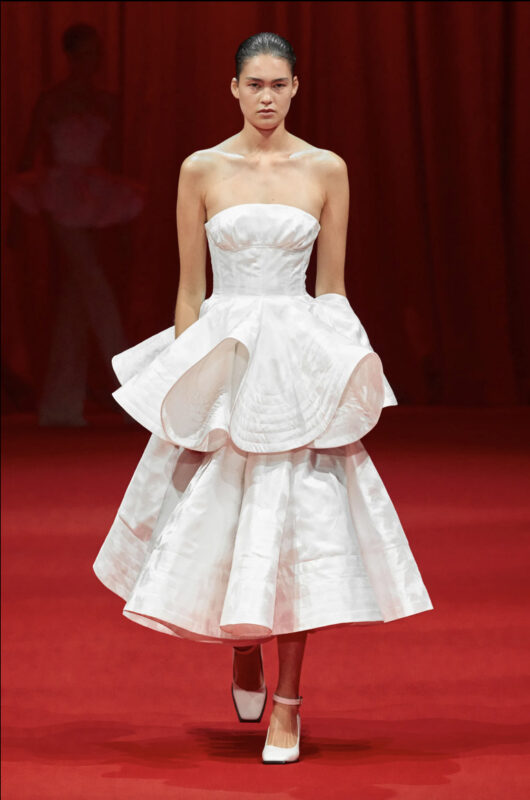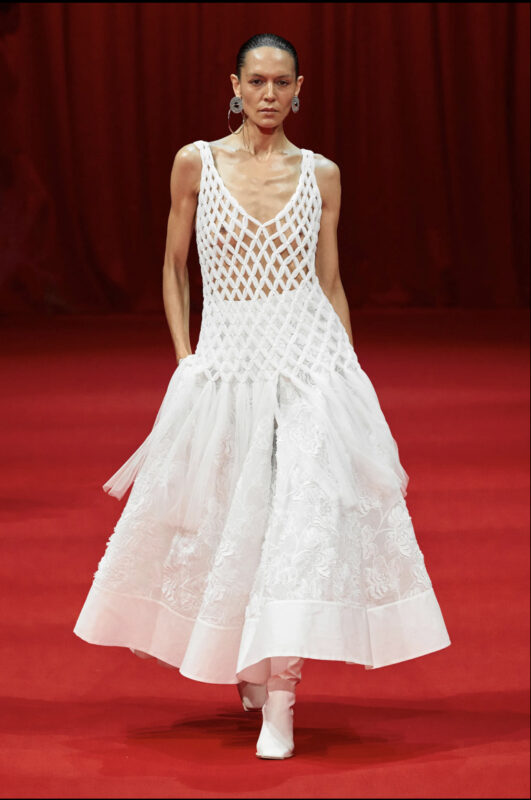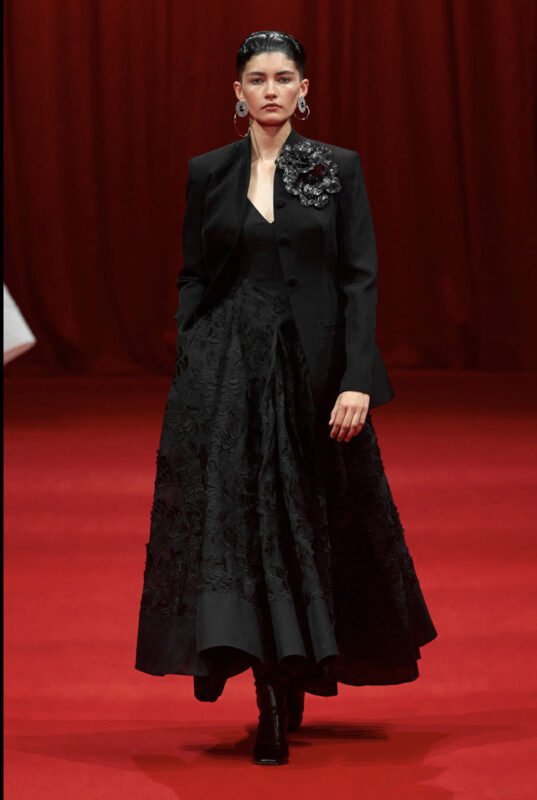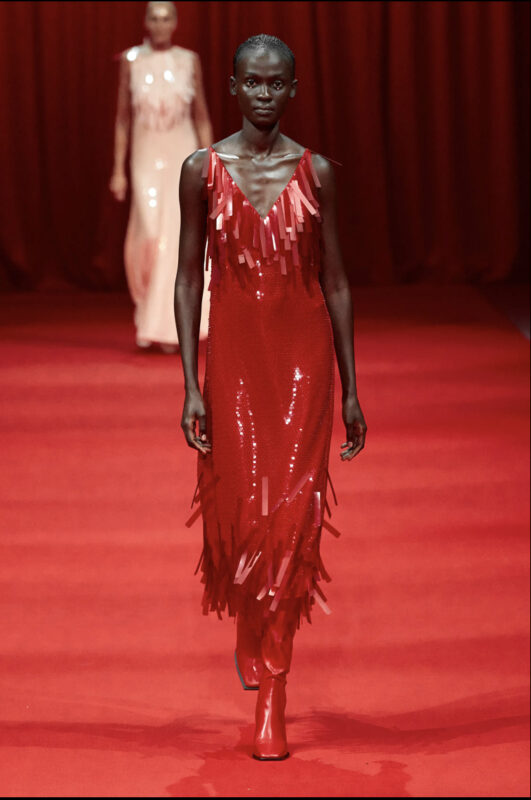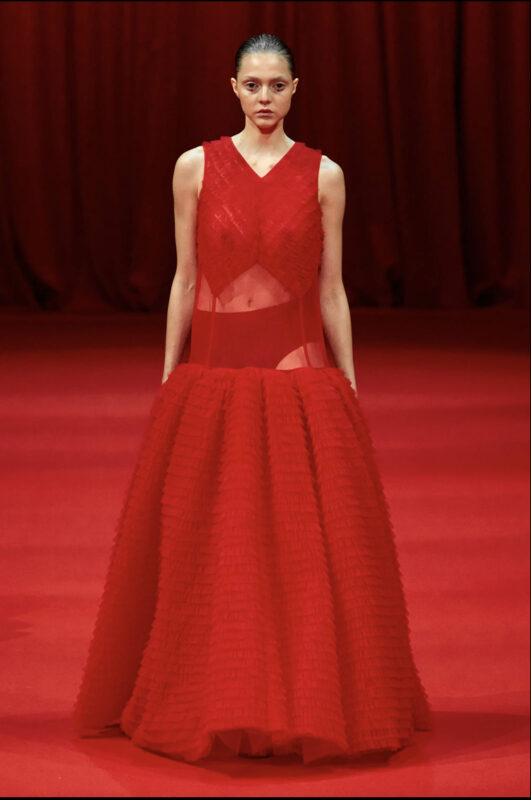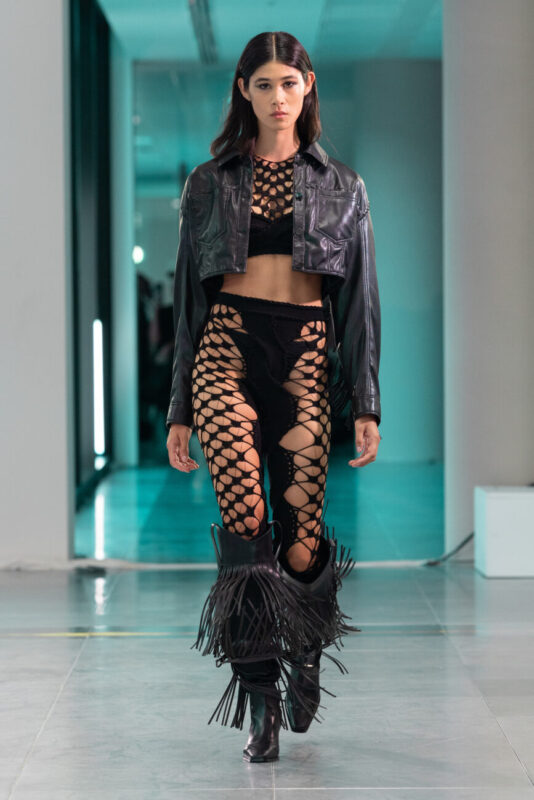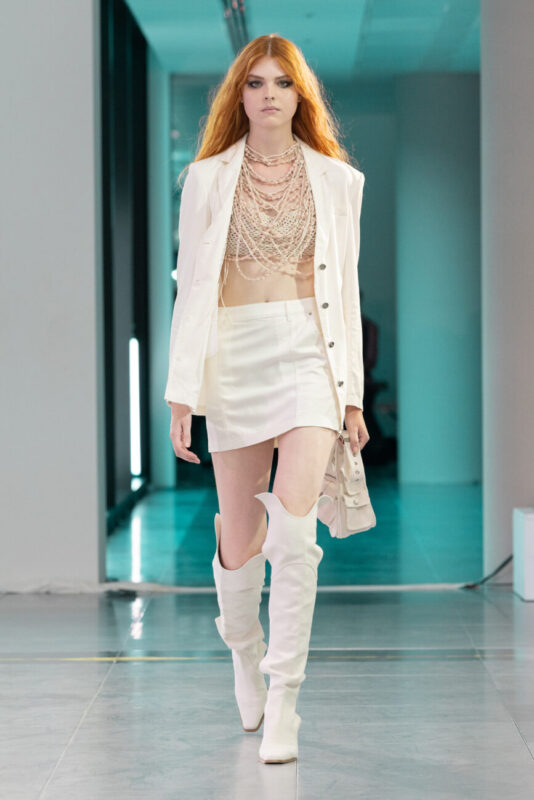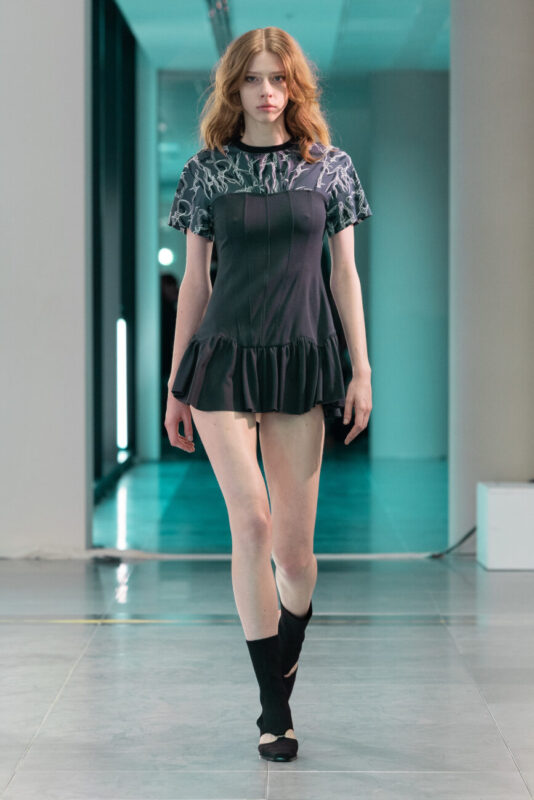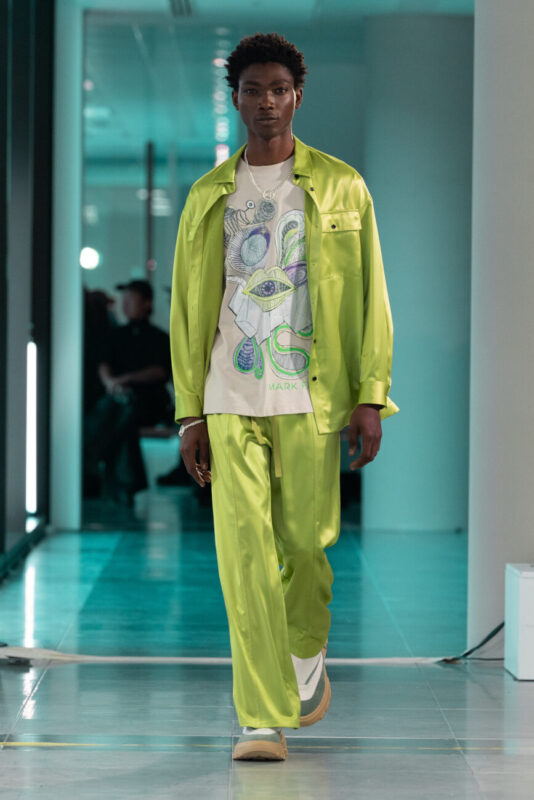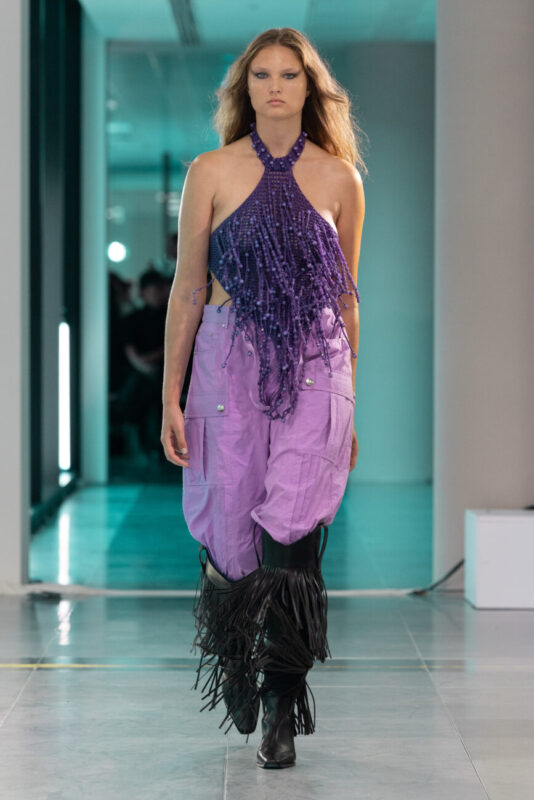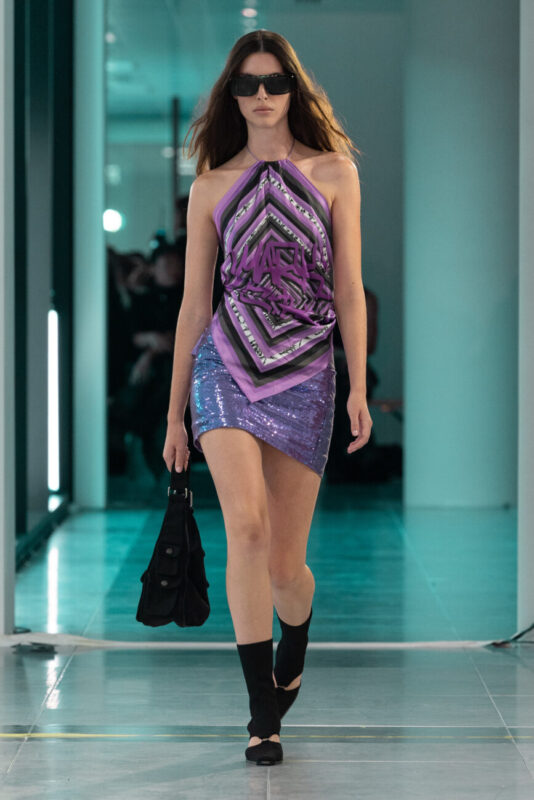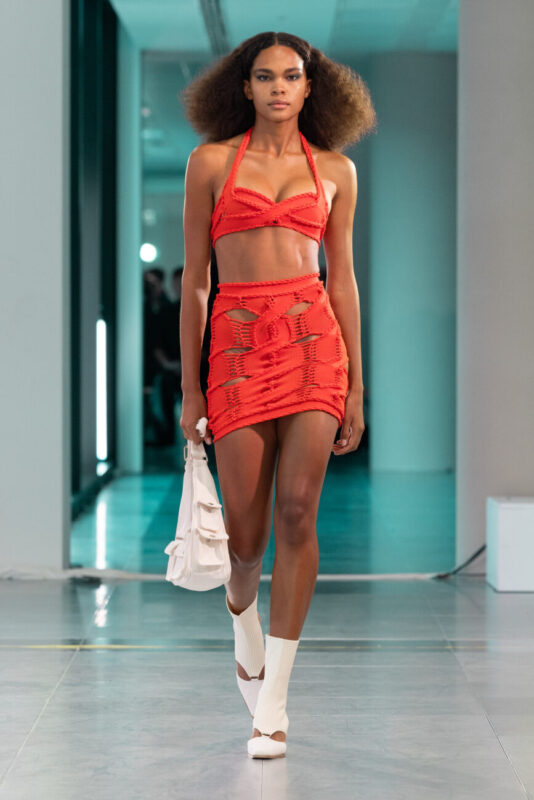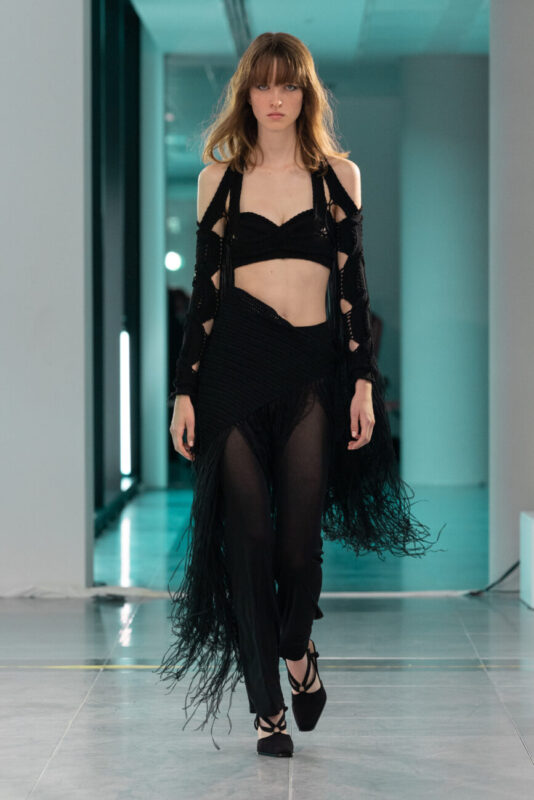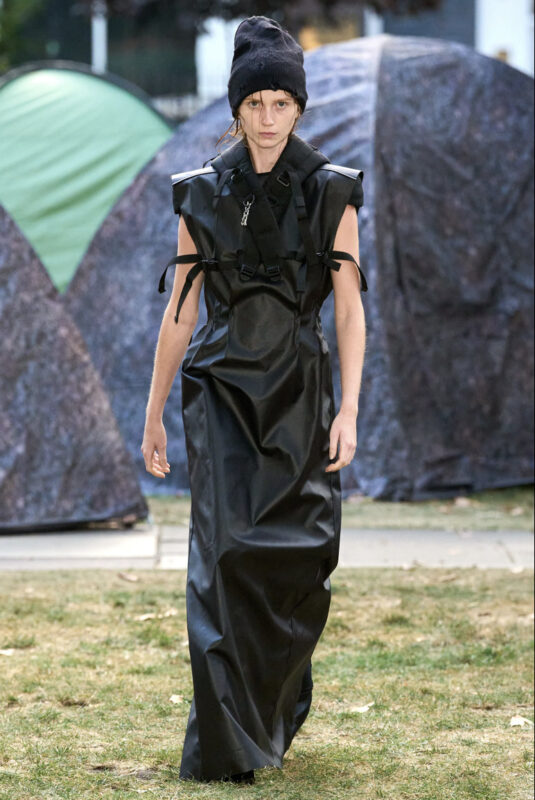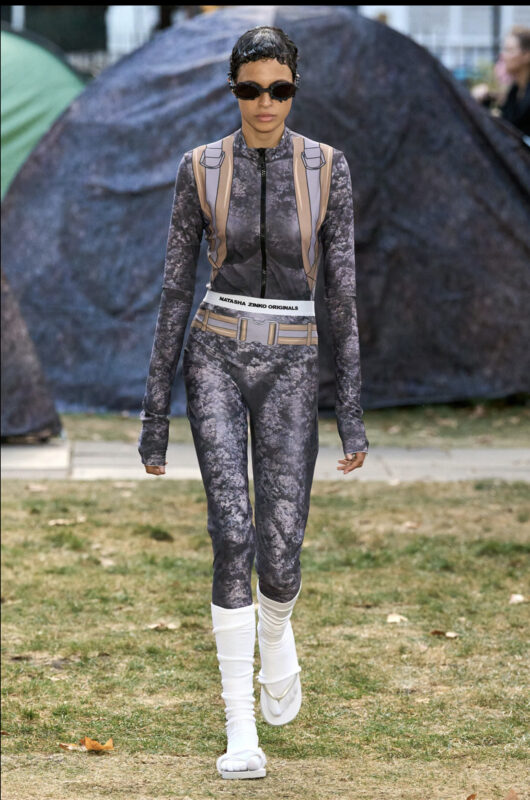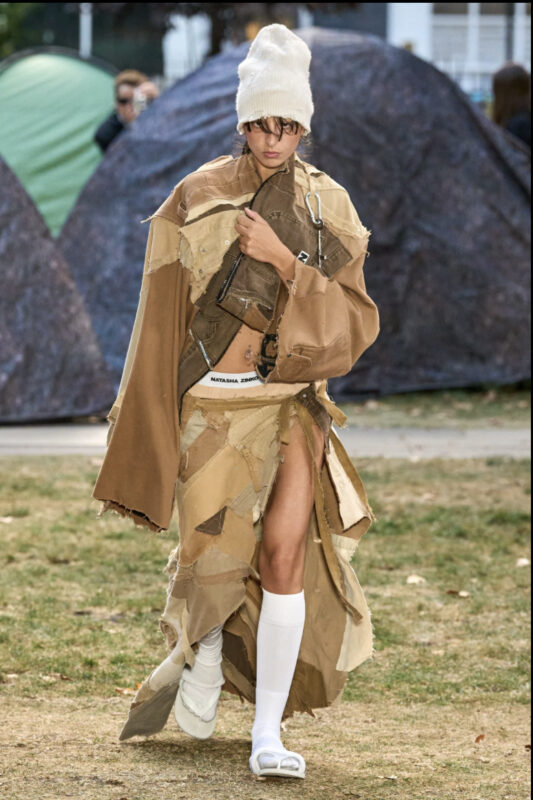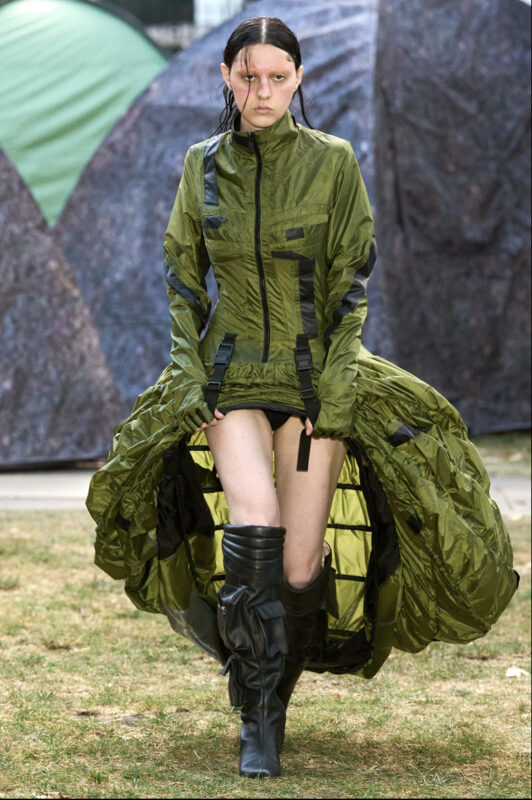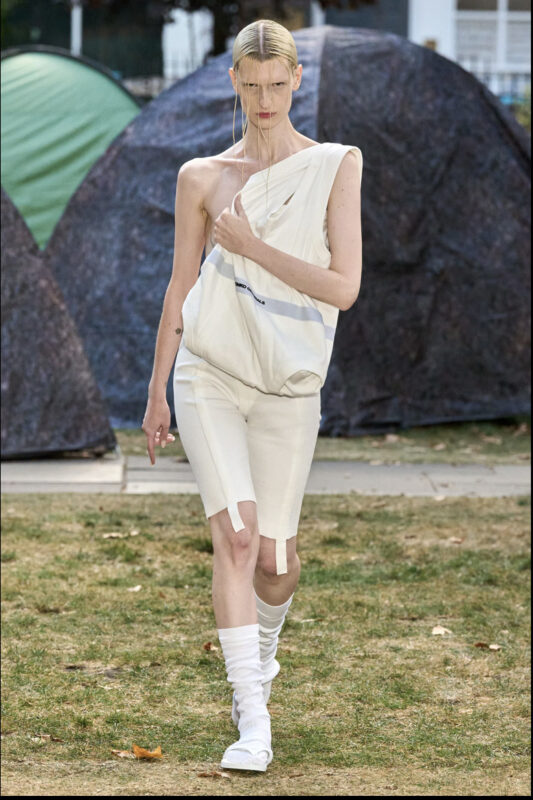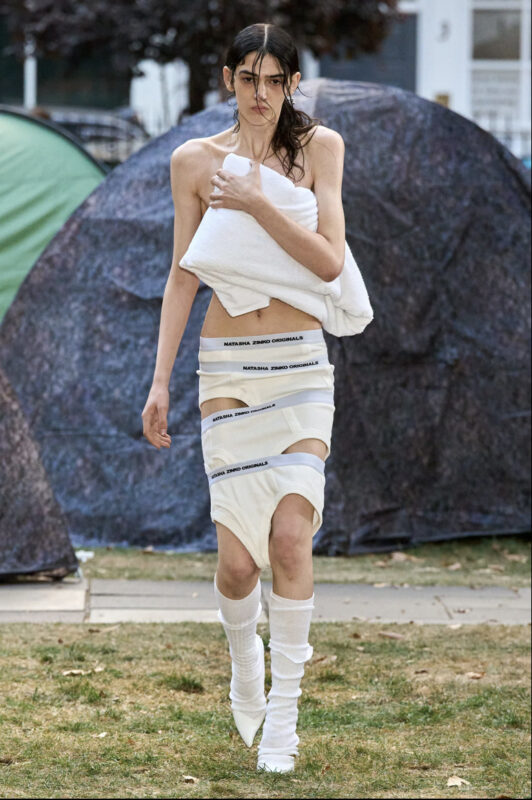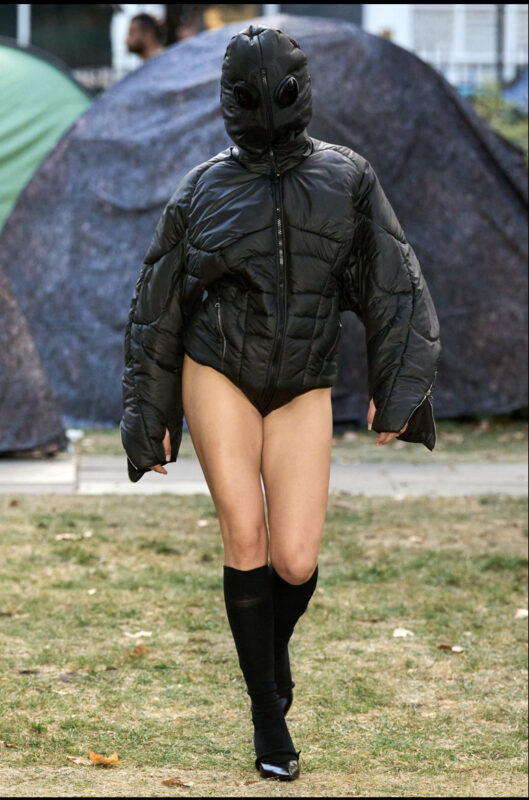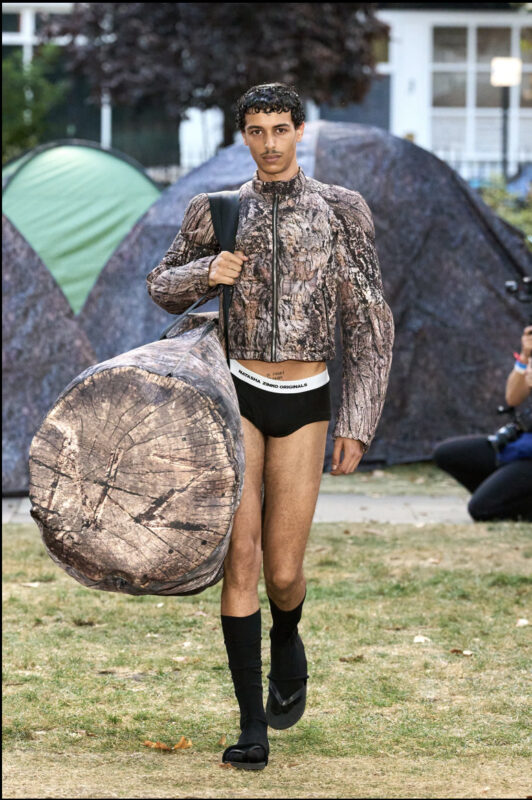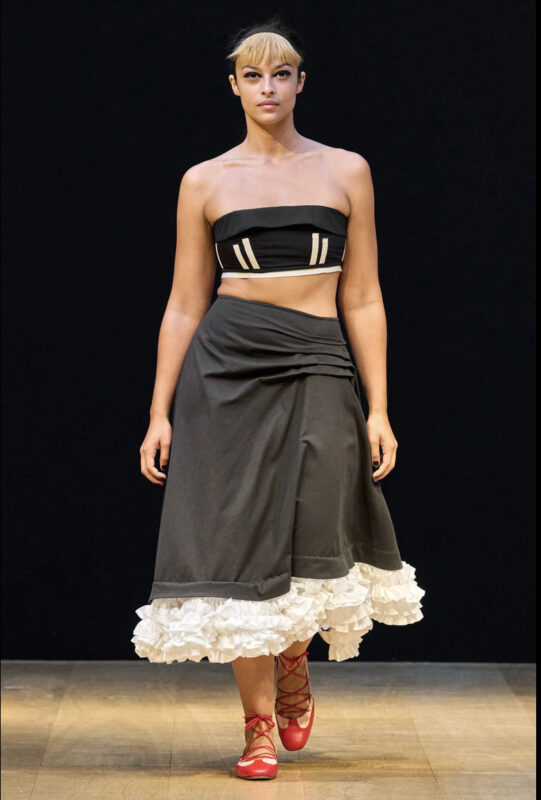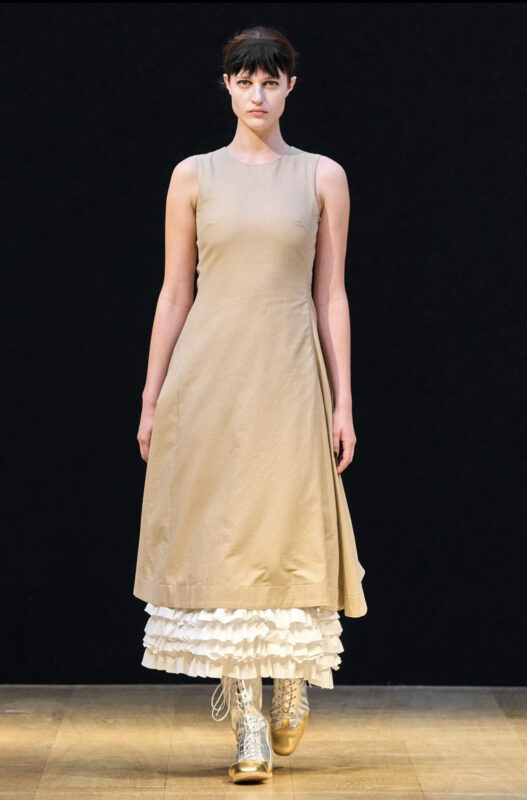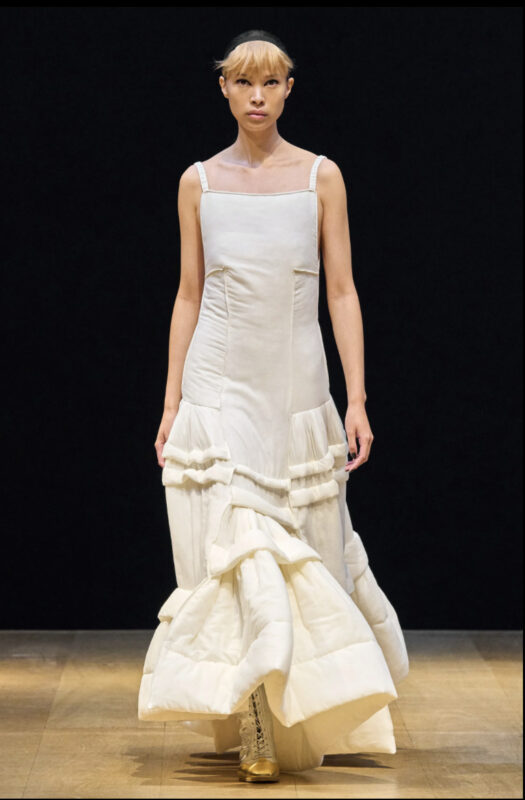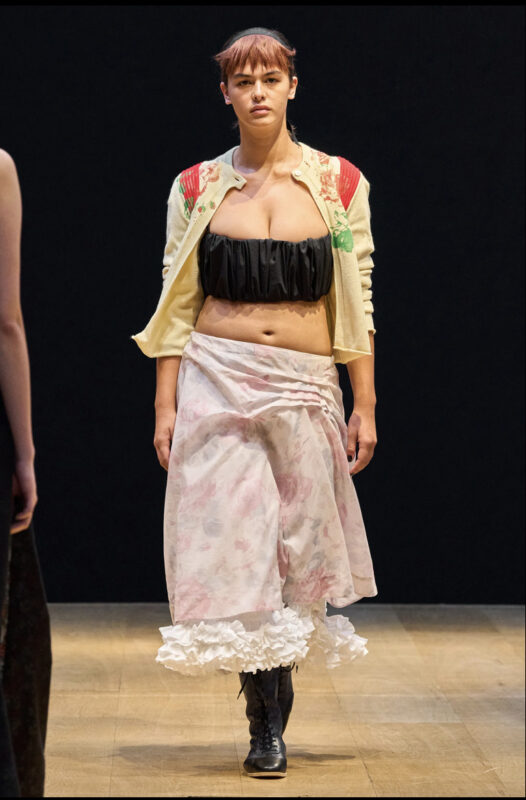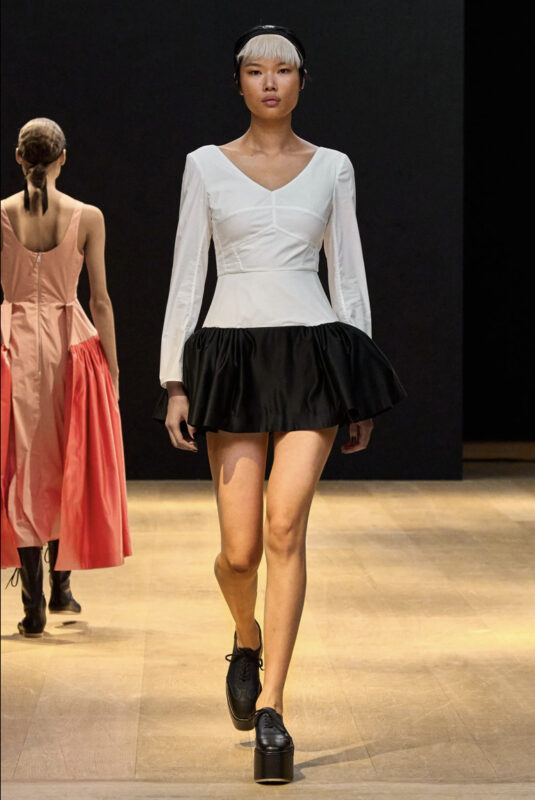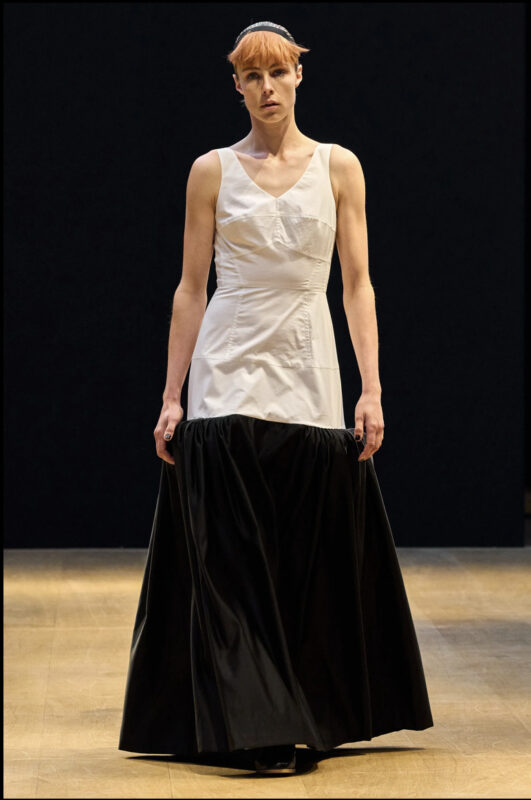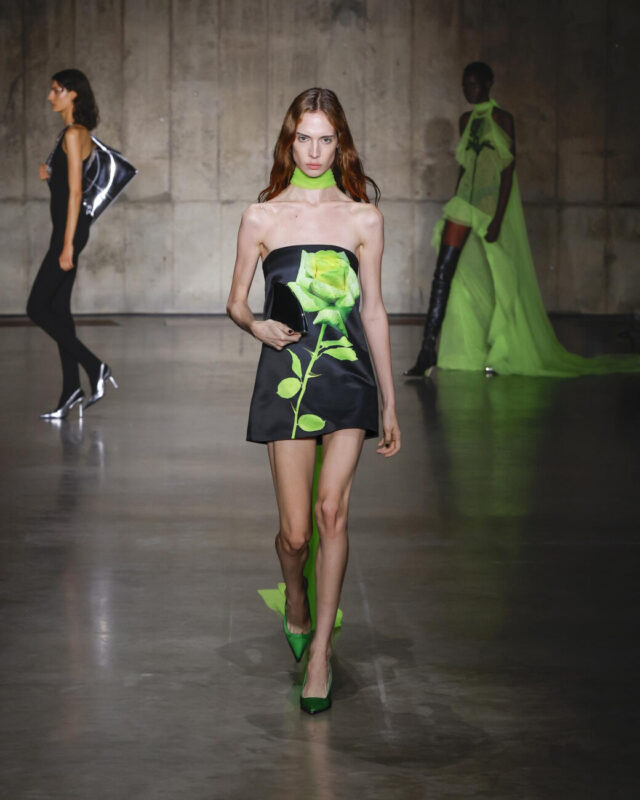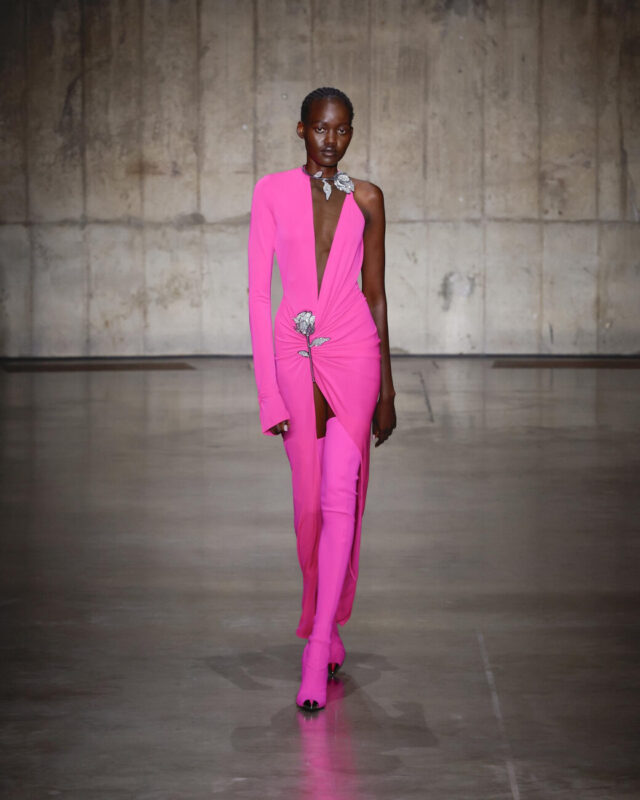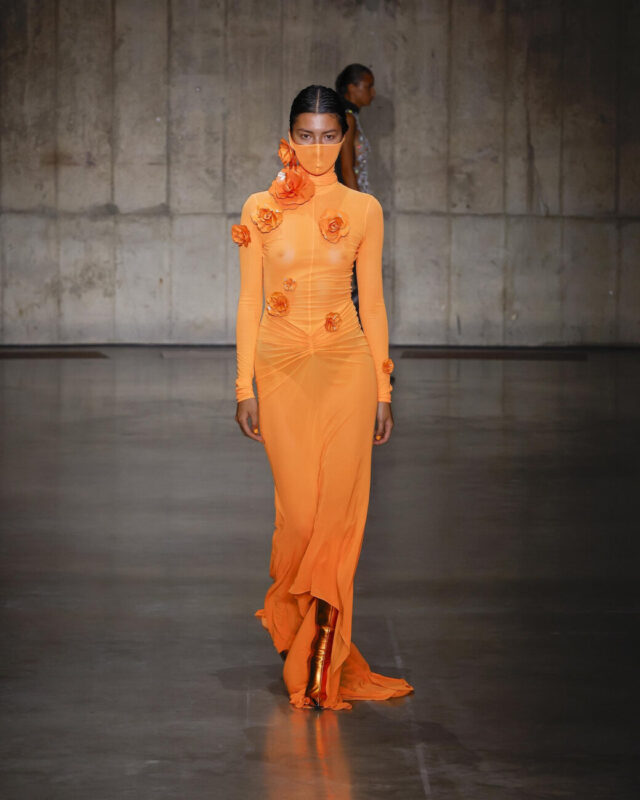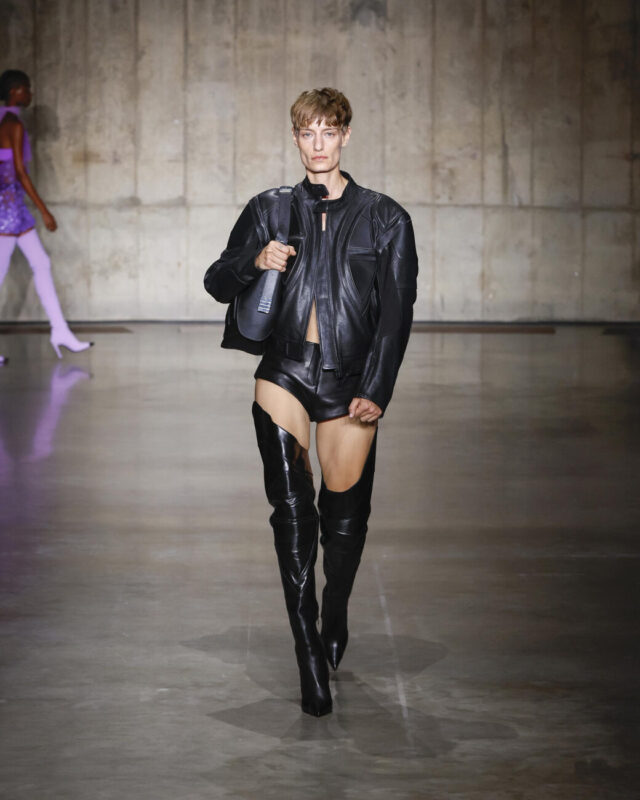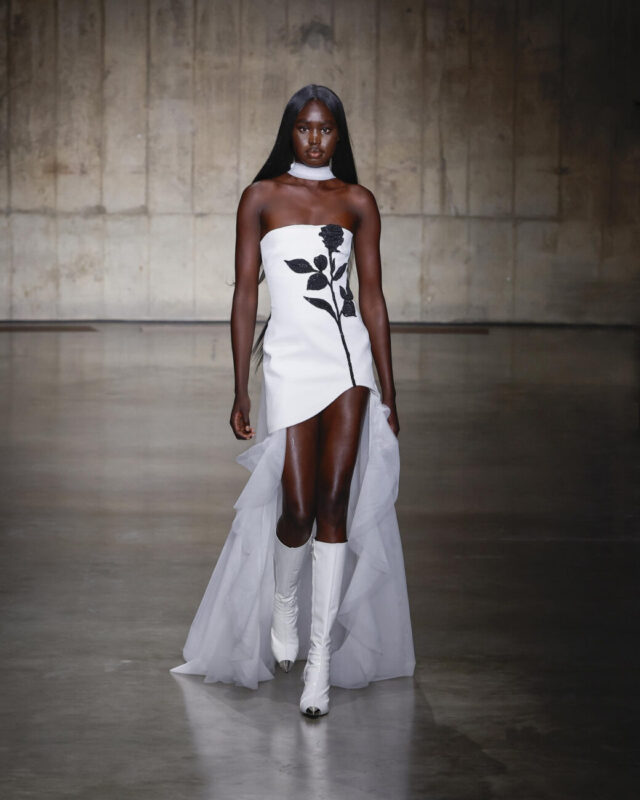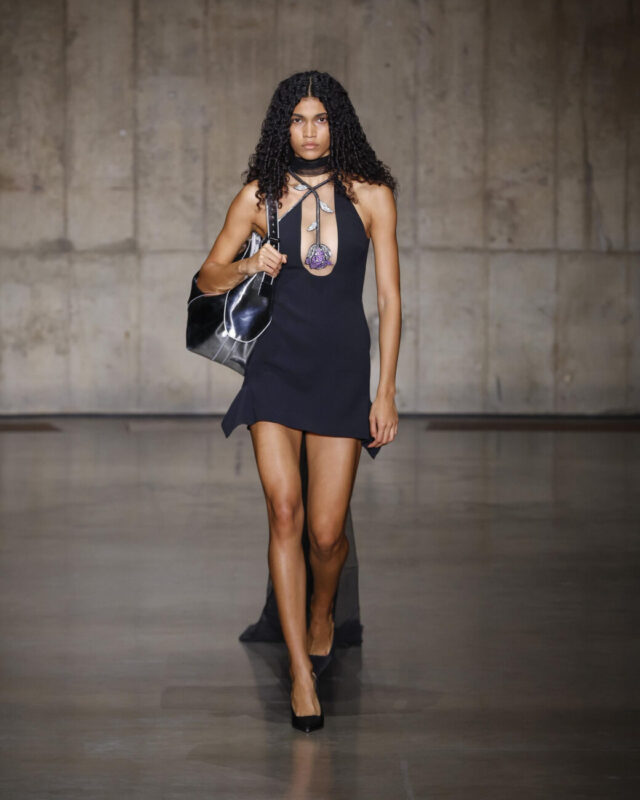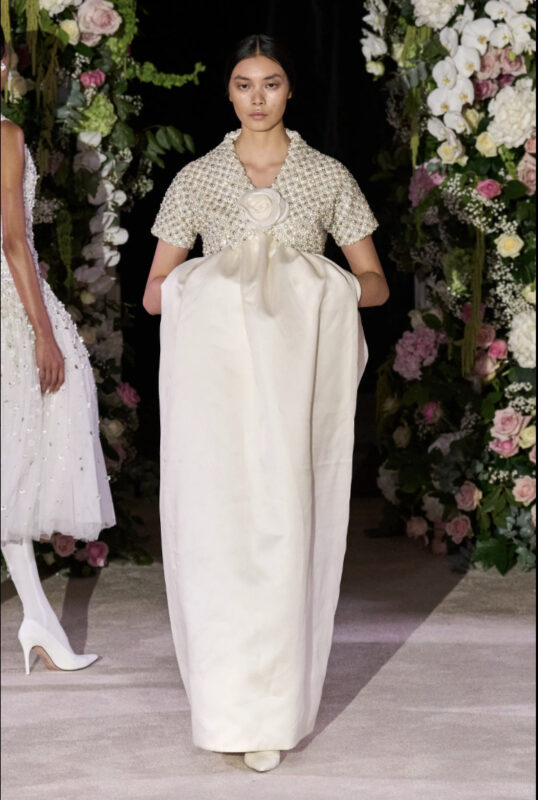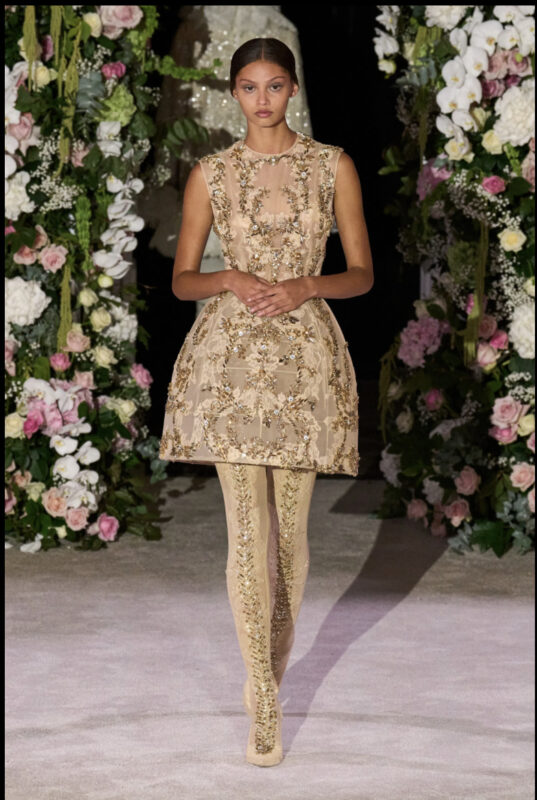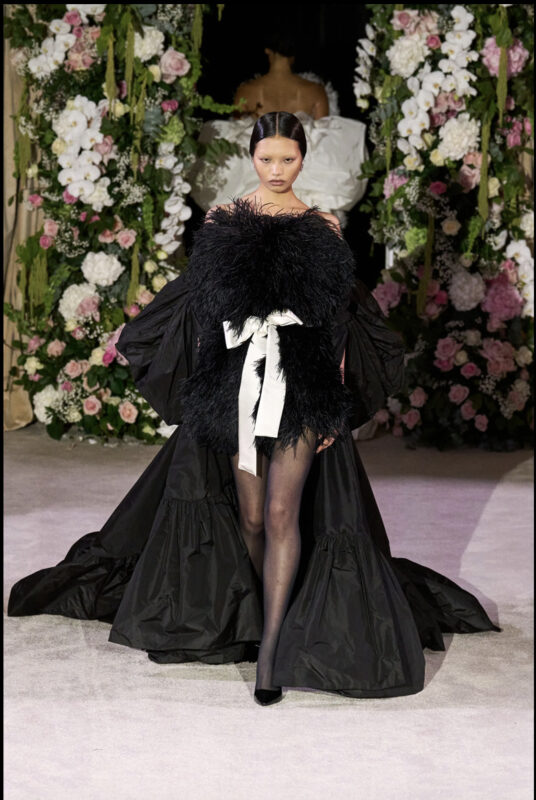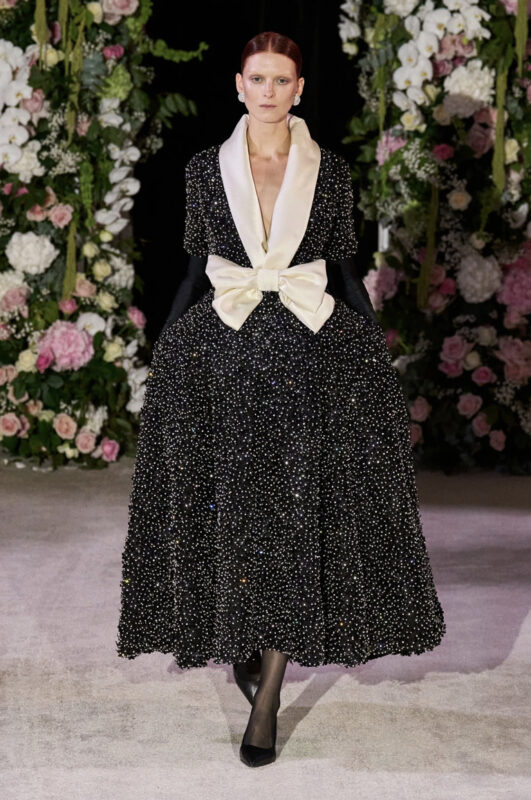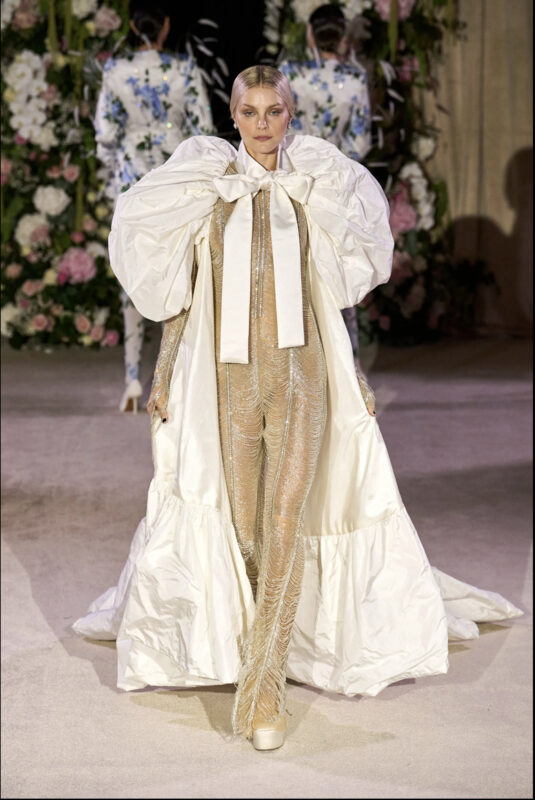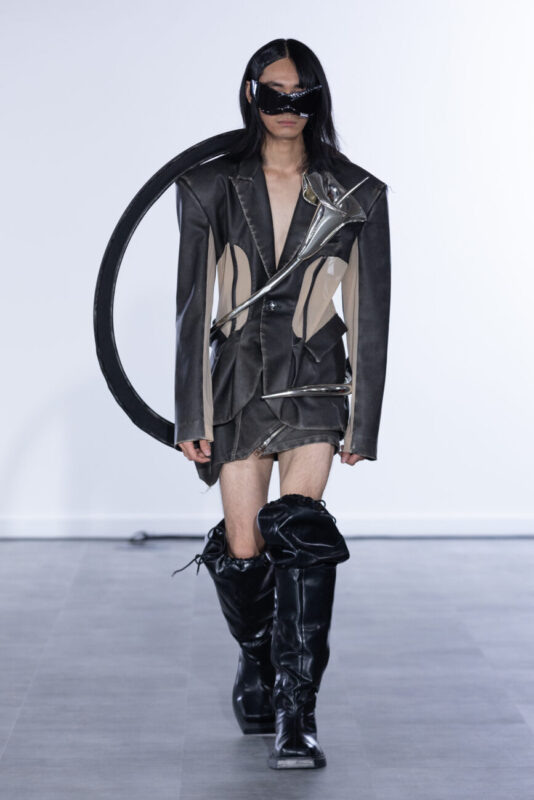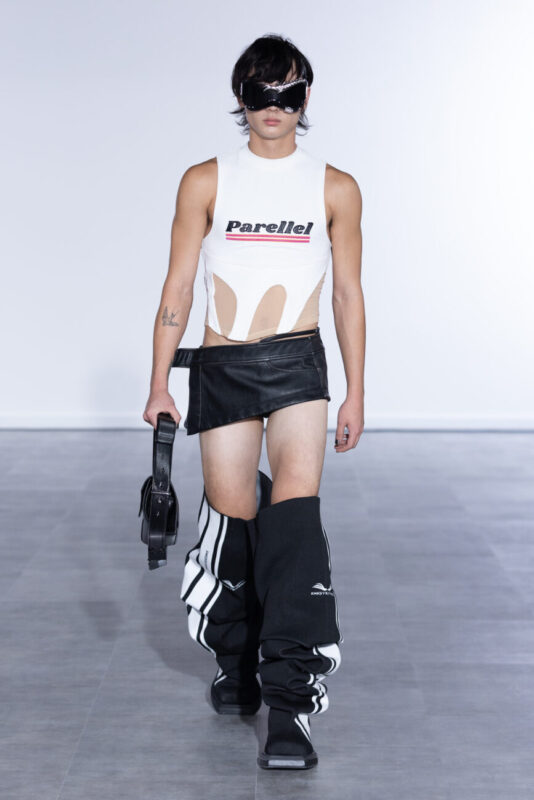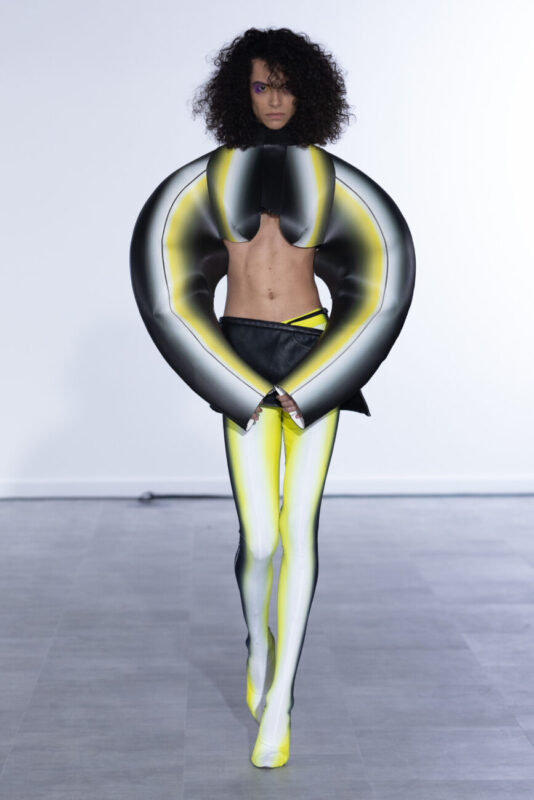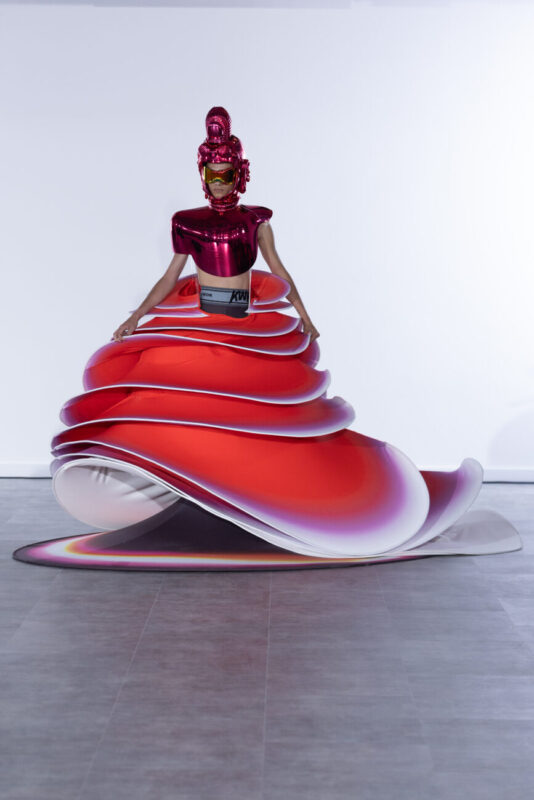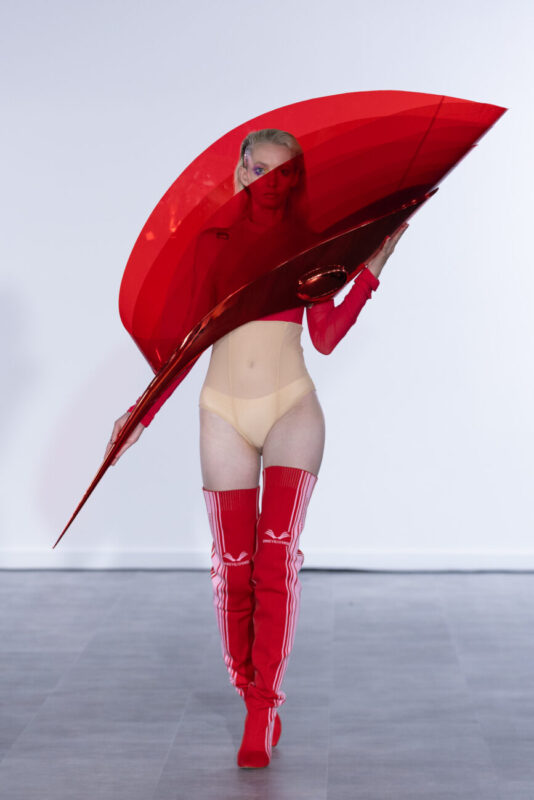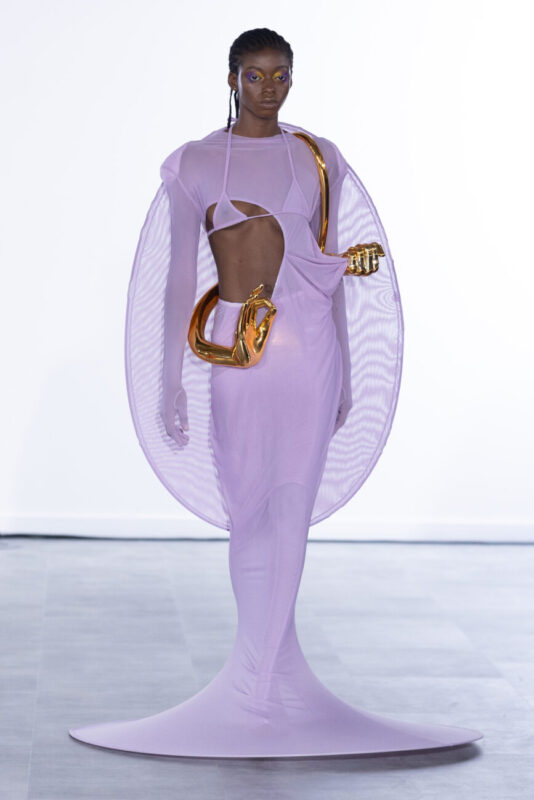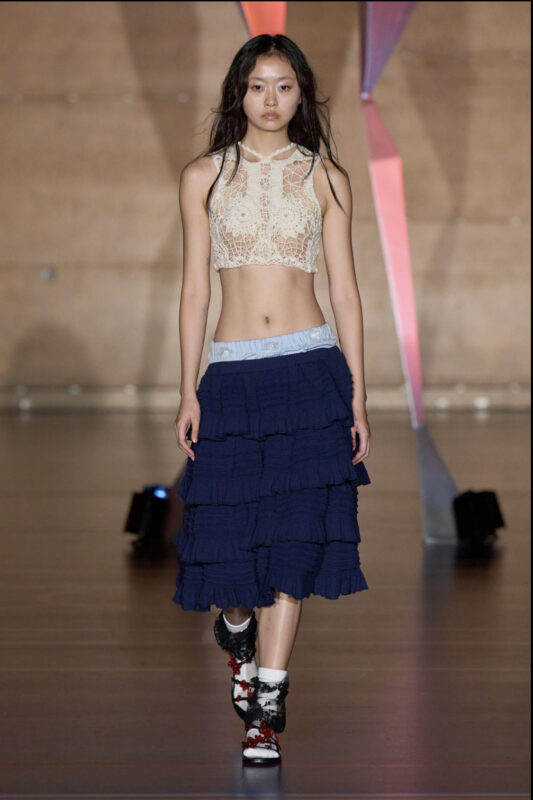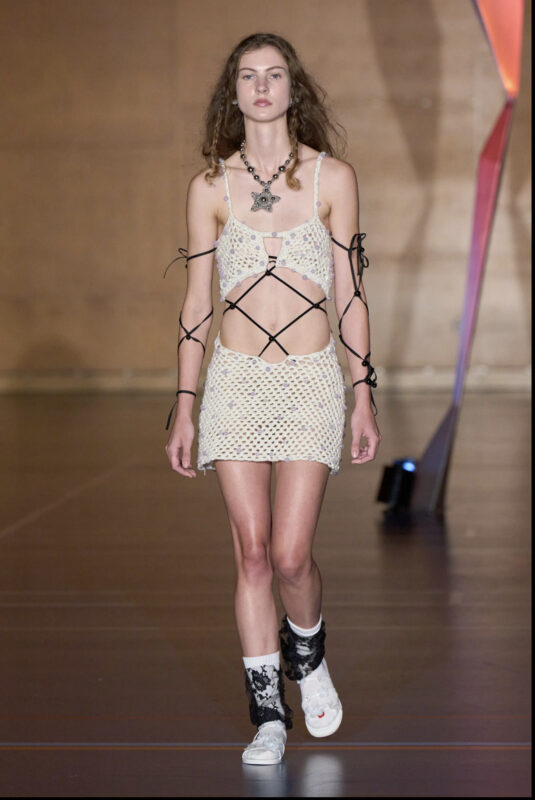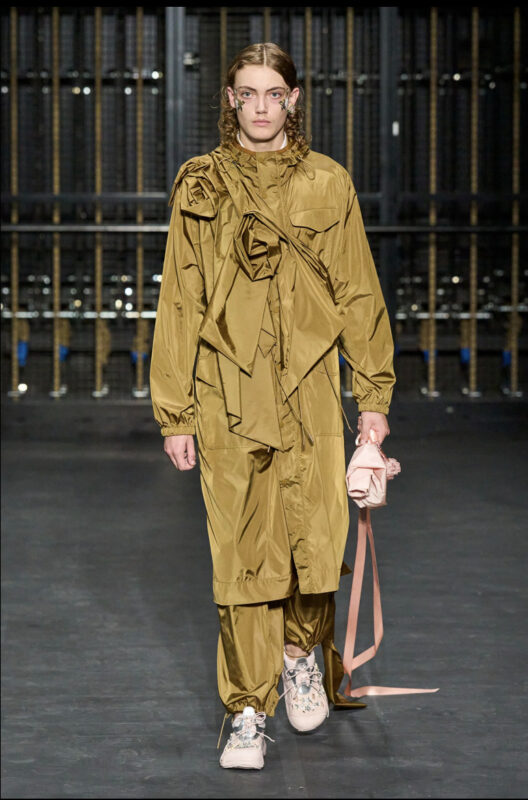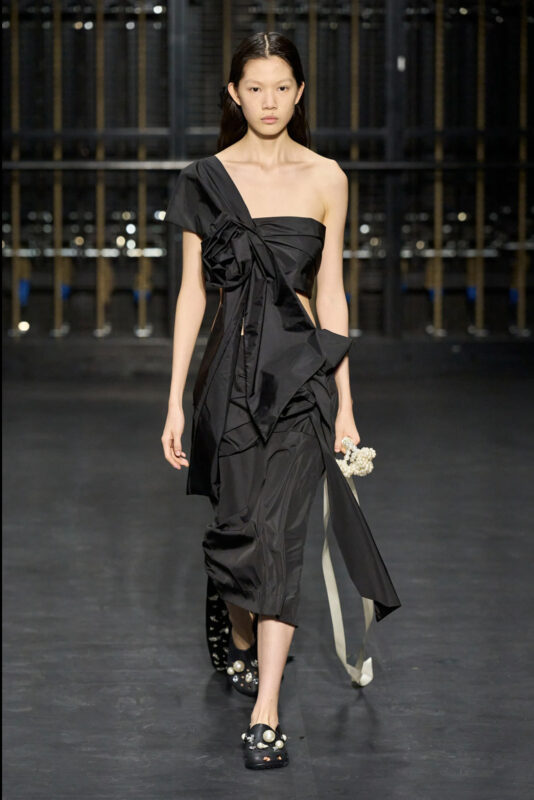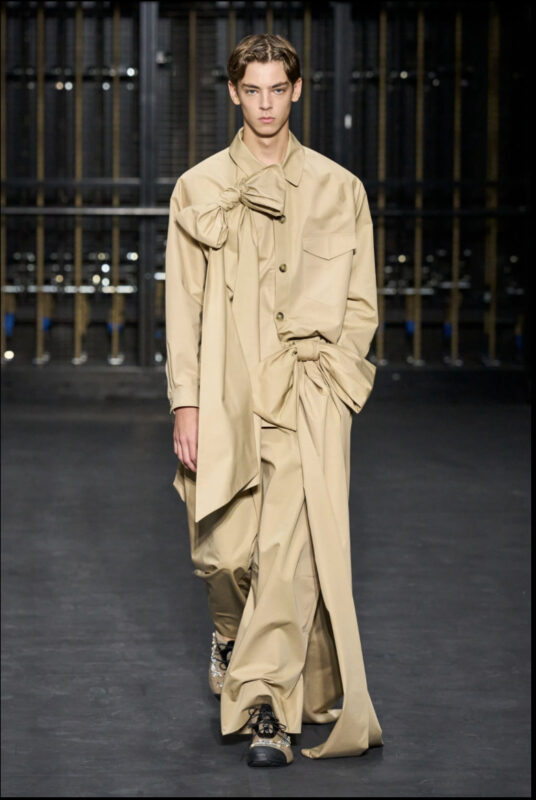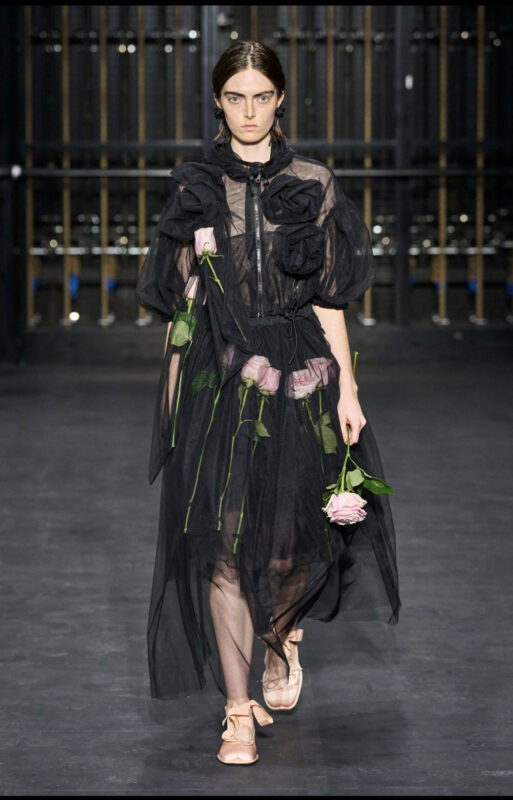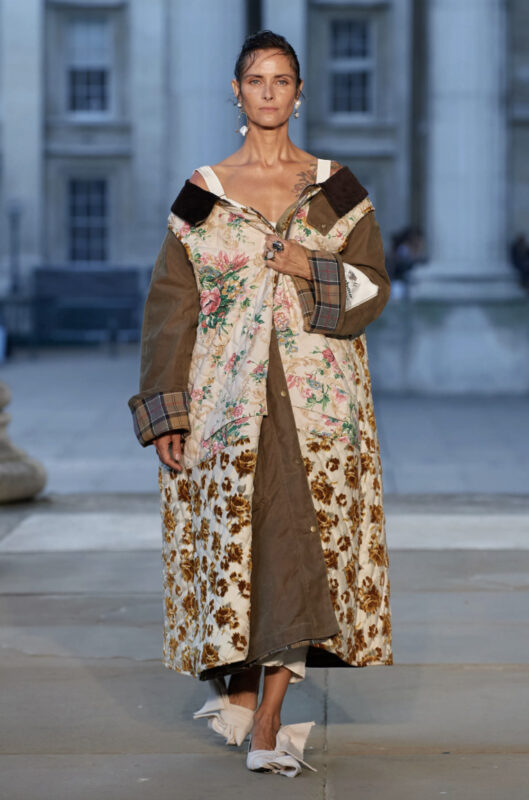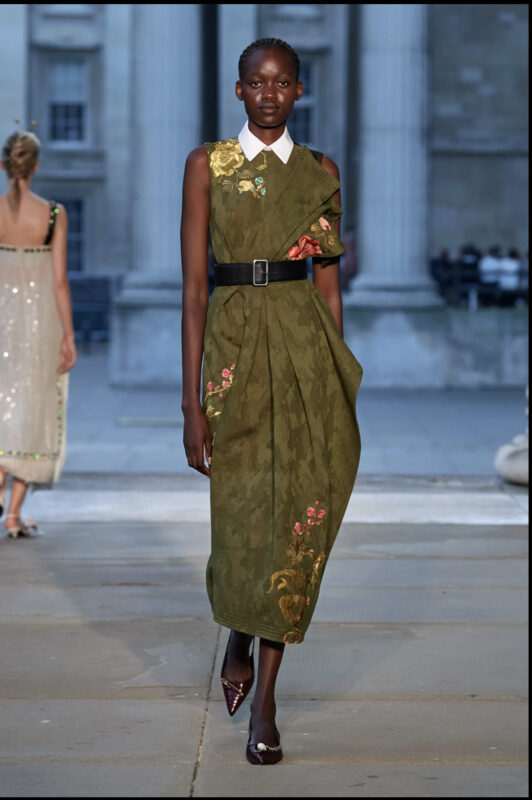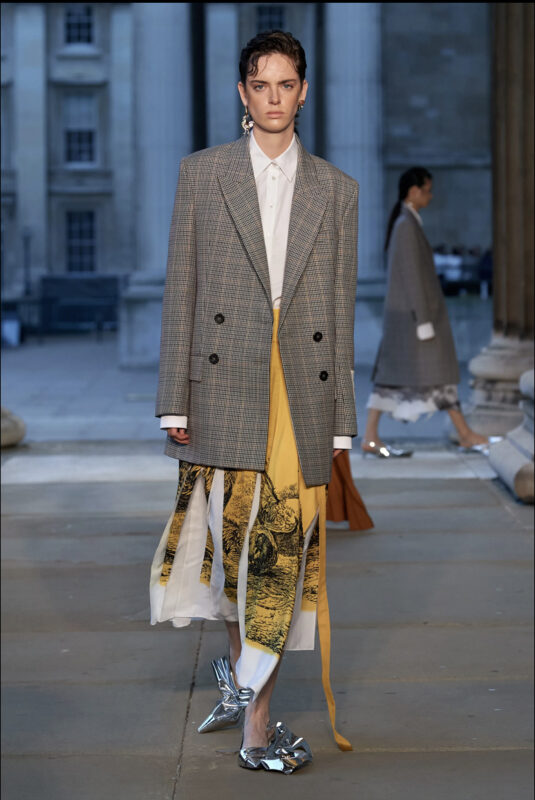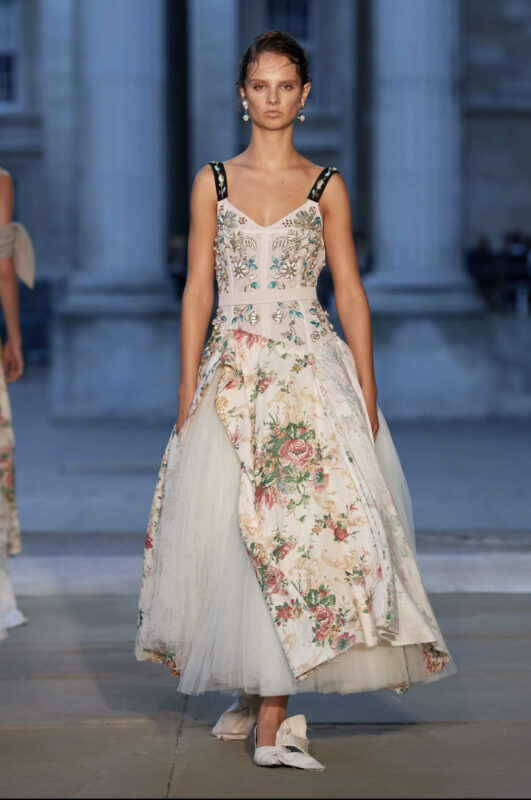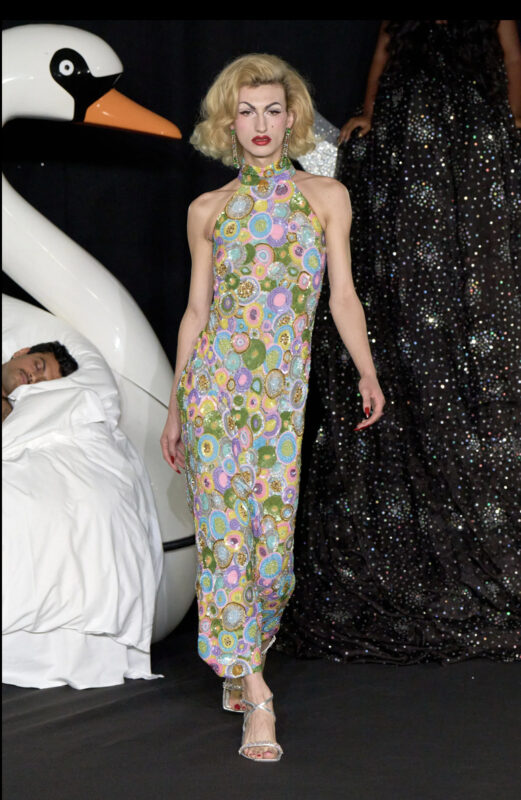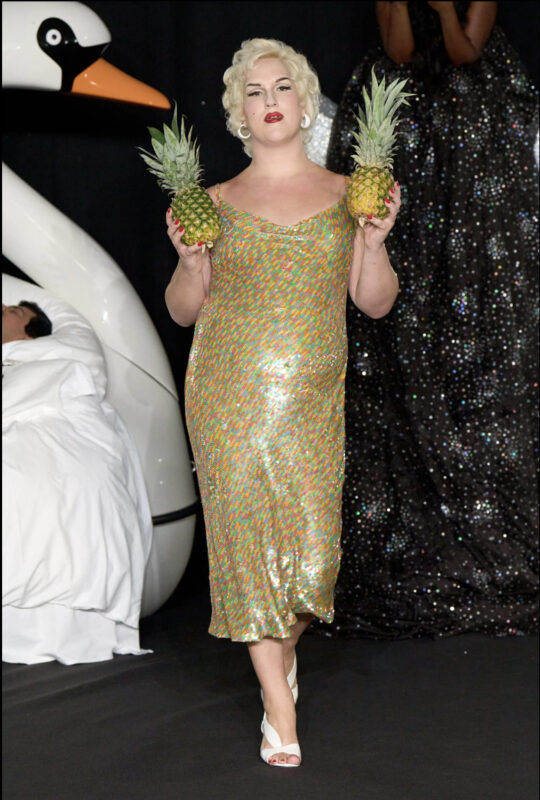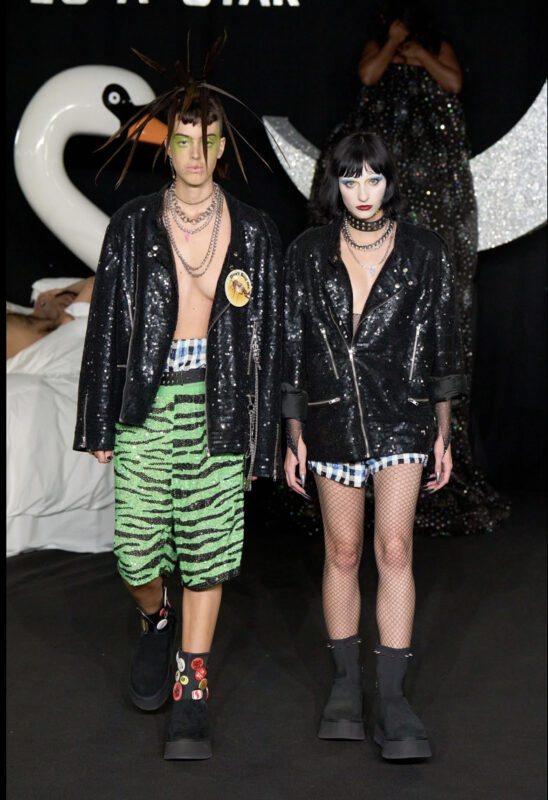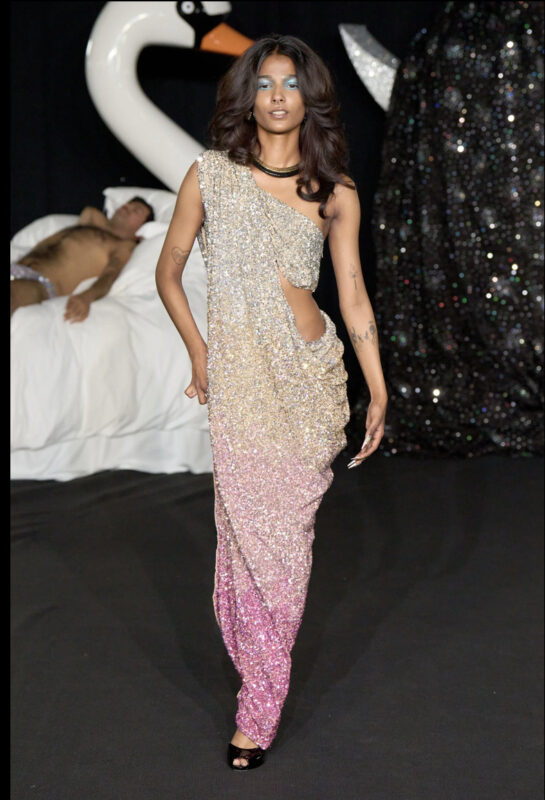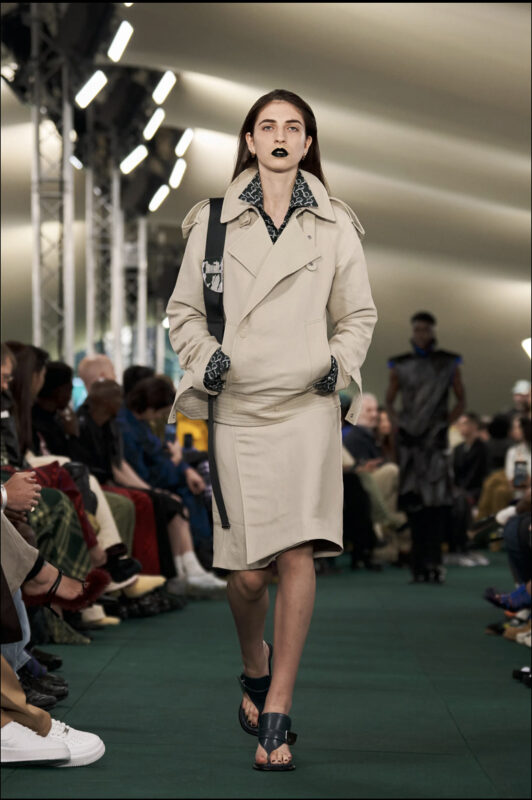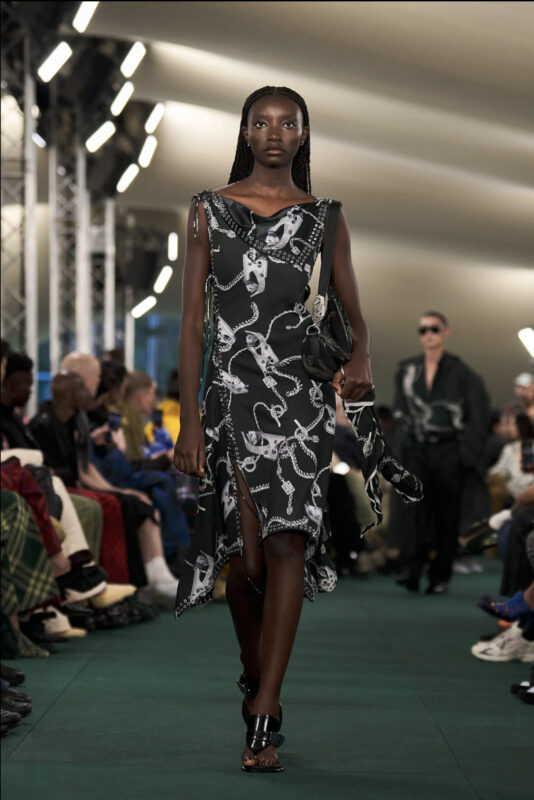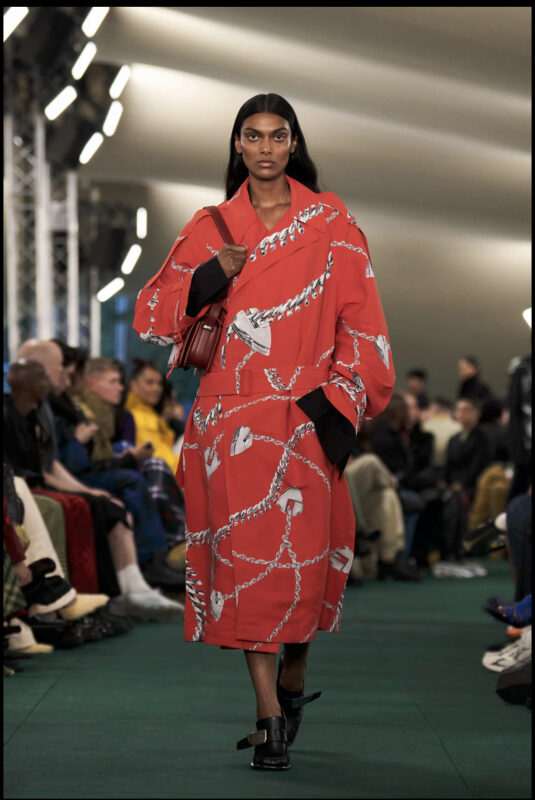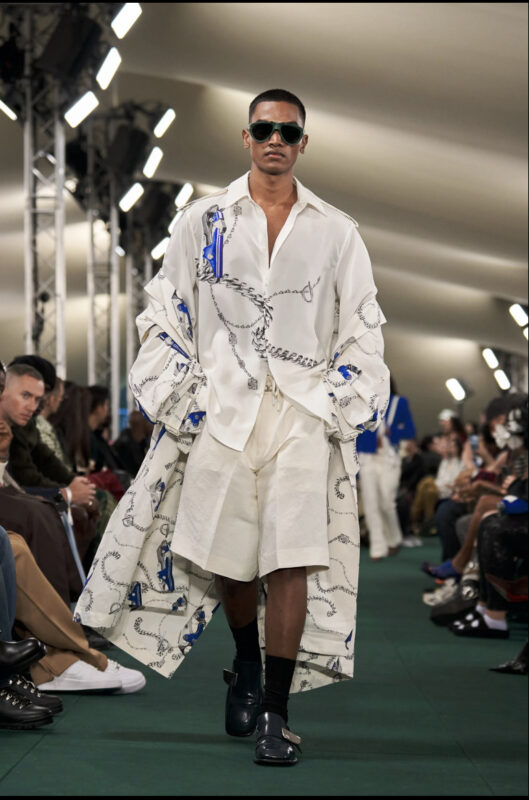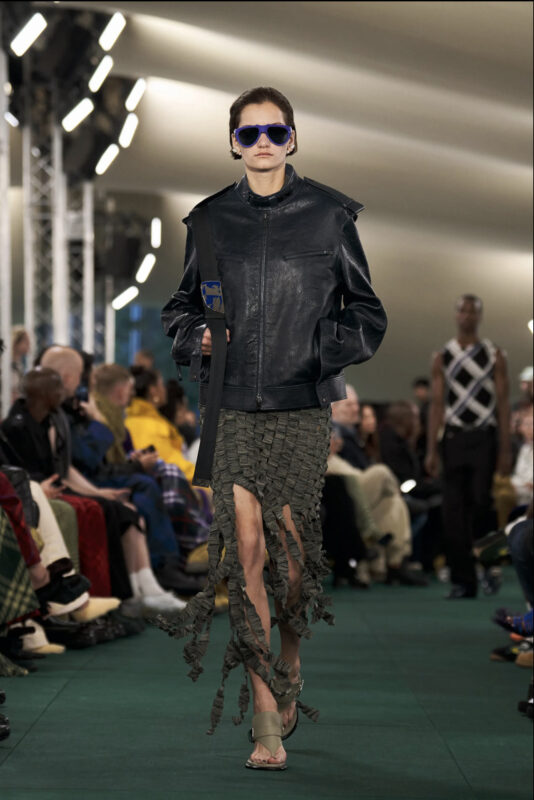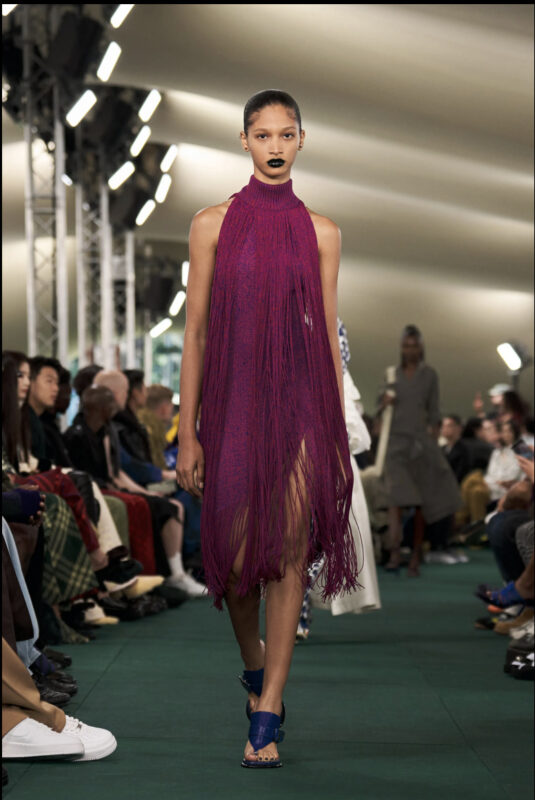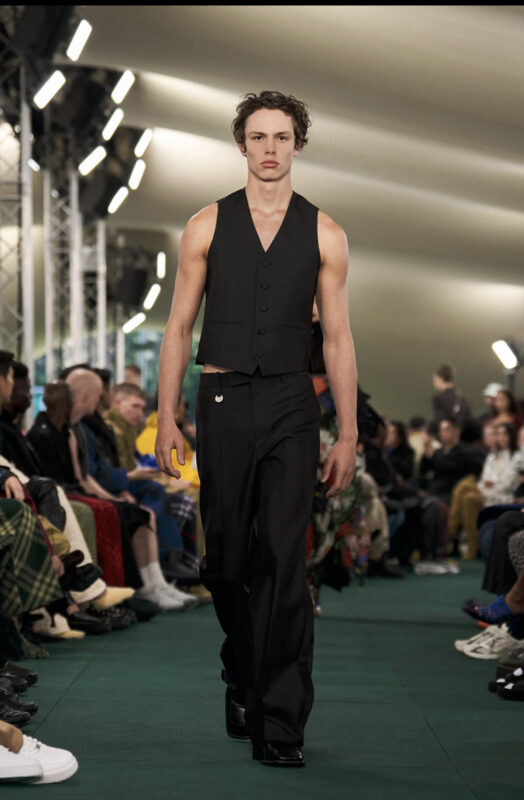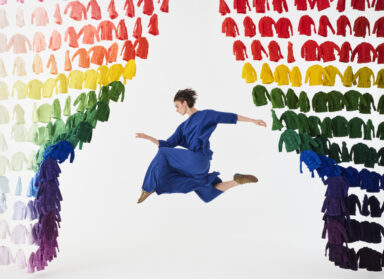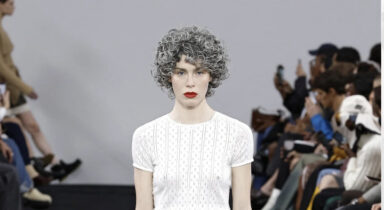A round up of the London Fashion Week highlights
August recently ended, but already we are getting news of the upcoming summer season. London Fashion Week restarts with a double spirit. On the one hand, the experimentations of many young fashion designers. On the other, some big names-Simon Rocha, Molly Goddard, Erdem or Richard Quinn, for example-who seem to have focused on formal reduction and simplification. London thus proposes a double track to follow. Certainly, London confirms itself as an unconventional scene, where even tradition is reimagined with a contemporary spirit. Here are highlights of everything we saw that excited us.
Edward Crutchley
Medieval people on a fashion photoshoot in the style of Steven Meisel. Striped clothes. Harlequins. Oversized tracksuits. Nineties school sports kits. Bardcore minimal. Football manager coats. These are the keywords to understand the latest collection by Edward Crutchley, who started with some AI-generated images and then printed them on jerseys and dresses. He said, “I find machine learning and machine creating fascinating. Not in a way that it’s all I want to use. But it is a really interesting tool to place within my process.” Presented at Marylebone Church, the collection looks to the 1990s, but through the lens of medieval Gothic. Each look references a spooky aesthetic that we might find in the books of Abraham Stoker or Mary Shelley. Jackets, shirts, and pants become a trompe d’oeil reminiscent of Gautier’s creations, but all turned to the somber, understated tones of black and white. A horror hallucination that fascinates with its freshness.
Huishan Zhang
Inspired by the film Suspiria by Italian director Luca Guadagnino and by the mesmerizing movements of German choreographer and dancer Pina Bauschdal, Huishan Zhang offers a collection in which lace is the distinctive element. This returns on satin dresses, or on denim flounced skirts. Zhang, for ten years now, has been pursuing a quest that tries to combine Western style and elegance with the craftsmanship and inspiration that comes from China, his home country. This collection, then, is further confirmation of that.
Mark Fast
The collection Dawn to Dusk is a celebration of nature’s timeless beauty with a touch of futuristic allure. Guided by a profound appreciation for life’s ever-changing rhythms, Fast‘s expertise shines through in carefully chosen linen blends, elastic stretch fabrics, and fresh light-weight denim. the collection is a tribute to the youthful spirit and throws us into a dimension where more formal garments meet futuristic aesthetics made of denim, bodices and asymmetrical and super colorful organza dresses. A fashion that meets the tastes of the youngest, especially at the time of body positivity.
Natasha Zinko
With The Camp, Natasha Zinko gives us a representation of what fashion would look like in a post-apocalyptic dystopian world. The looks look like something out of an episode of The Last of Us, with prints that mimic rocks and tree bark, super tight Lycra jumpsuits and work clothes with many, many pockets. The Ukrainian designer brings to the runway a tribe that looks like it could inhabit the deserted cities of a world now in ruins. The watchword seems to be convenience and functionality. Nevertheless, there is no lack of attention to detail, as can be seen in leather jackets that mimic body muscles and emphasize the bust. Natasha Zinko’s is a direct, immediate approach that denounces what fashion should be today. A reflective tool to give perspective on our time. In a world falling apart, the only thing that perhaps makes sense to do is to try to live in the ruins, populate them, create safe spaces for humanity. Natasha Zinko’s Postapocalyptic Tribe seems to be able to do just that.
Molly Goddard
The inspiration behind Molly Goddard’s research for this season is clear: Victorian London and the art of nineteenth-century England. “I had [looked at] photos of Victorian christening gowns and even older ones, where babies are smooshed up in their dresses with things poking and squidging out underneath,” she said. Crinolines, petticoats, cone bras, lace. Elements from the past are used by the British designer for a romantic and modern vision of femininity. Bowns and floral prints give life to a parade of contemporary cocottes that could have come out of Proust’s prose, were it not for a vibrant, unprecedented vibe. Molly Goddard, in fact, works on subtraction, and the collection keeps a perfect balance between historical references and contemporary minimalism. The only quirk allowed is organza, which flows copiously in large metrics. With these premises, it is no coincidence that the fashion show takes place inside the London headquarters of Christie’s. An ode to the lost poetry of nineteenth-century England.
David Koma
The springtime floral is a timeless trope, a creative cliché, and a fashion institution in its own right. While the signature surface decorations of David Koma have often taken floral form, the sweetness associated with the classic flower motif constitutes something of a contrast to his practice. The Spring-Summer 2024 Collection embraces this divergence in an exploration of floral romanticism within the glamorous modernism of David Koma. Through Georgian designer’s adopted London gaze, the notion prompts the idea of the English rose as embodied by a young Elizabeth II. Building on this inspiration, David Koma represents a multifaceted and versatile collection, blending Marianne Faithfull’s English rose in 1968’s The Girl on a Motorcycle with expressions of the most sensual femininity: the London spirit in its purest form.
Richard Quinn
The last runway show of Richard Quinn, dedicated to his father, began with a ballet sequence, performed in an appropriately romantic Richard Quinn dress, of course. Each guest was also given a rose, which in fact is the chiabe element of this collection. Indeed, this symbol returns in many looks: printed on long dresses, embroidered or applied. Richard Quinn almost seems to pay homage to Christian Dior, with designs that clearly look back to the old-fashioned elegance of the 1950s New Look. Nonetheless, the whole collection is imbued with a sense of modern restlessness, inspired perhaps by some of compatriot Alexander McQueen’s designs. With this collection, Richard Quinn reaffirms that sartorial elegance is not dead but, on the contrary, can still speak the language of contemporary fashion. In the midst of wars and pandemics, Richard Quinn seems to offer an escape route, an oasis of peace where beauty reigns.
KWK by KAY KWOK
KWK by Kay Kwok returns to London for its 2024 Spring-Summer collection. This season views the brand’s ethos of transportation out of the mundane through a spiritual lens, exploring how through looking within and connecting with our authentic self-expression, we arrive at a new place of vivid-colour and exaggeration. The Chinese fashion designer, who debuted in London a decade ago now, presents a futuristic collection where clothes are mixed with sculptural pieces that seem to come from deep space. Nonetheless, the roots are firmly rooted in reality and the brand’s heritage. The prints seem to hark back to the aesthetics of 1980s Hajime Sorayama. The aesthetic is clearly a super futuristic version of Y2K, which we could call space clubbing. Evocative and intense, this season has been designed to imbue a sense of pleasure and ecstasy, quasi-religious in nature-and enlightenment.
Susan Fang
What happens when human feelings meet new technologies? What happens when the beauty of the human body hybridizes with the mechanomorphic forms of androids? Susan Fang’s new collection seems to answer these questions. For this her summer collection, the Chinese designer seems to transport us to a world where artificial intelligence meets the natural world. Artificial intelligence-generated prints are used alongside soft organza and lace dresses, while accessories become futuristic objects adorned with bio-inspired flowers. Make way for experimentation as well, with a dress made with 3D printing and handcrafted with 600 protruding beads. And Susan Fang stays true to her commitment to sustainability. In fact, about 90 percent of the fabrics used in this collection come from the recovery of discarded or excess materials. Thus, the Chinese designer shows us how a dialogue between the human and the nonhuman is still possible.
Simone Rocha
Set in the headquarters of the English National Ballet, Simone Rocha’s latest collection is meant to be a tribute to the world of dance. Titled The Dress Rehearsal, this summer collection sees the return of crinolines, lace, taffeta. The rose-an obsession of various designers this season-also becomes a recurring element here, pinning itself on trenches in the form of fabric embroidery or printing itself on organza dresses. A puritan aesthetic seems to dominate over the whole collection, if it were not for a few details that make a difference. Semi-transparent dresses hint at bodily nudity, silk bomber jackets and suits curl up, and minidresses become provocative. Also, exploring “the creative juxtaposition of femininity and utilitarianism to bring to life new designs,” Rocha collaborates with the brand Crocs, for a novel version of footwear. Perhaps, while designing the collection, Simone Rocha was not thinking of the angel woman, pure and immaculate, but of a modern femme fatale: a mysterious, seductive and sometimes dangerous Black Swann.
Erdem
For his summer collection, fashion designer Erdem Moralioglu looks to the traditions of 1940s and 1950s England. More specifically, Erdem took as his inspiration Deborah “Debo” Cavendish, wife of Andrew Cavendish and duchess of Devonshire for more than 50 years. The fashion designer confesses that he was lucky enough to work with the textile and jewelry archivists at Chatsworth, and with Helen Marchant, Debo’s former private secretary. The result is a collection in which the floral prints of 1950s tapestries are patched with vintage tweed, Elivis-inspired leather and tulle gowns. Debo’s great passion for insects is recalled with a tiara in the shape of bug antennae. Flat shoes are embellished with a maxi bow, because details make all the difference. Erdem’s is a collection suspended between the chic taste of British aristocracy and the rebellious spirit of young misfits. An updated and convincing version of an allure that seems to be disappearing today.
Ashish
Ashish Gupta, designer of the eponymous brand, instead throws us into a totally different visual universe. Here, too, we look back to the past, but not to the rarefied atmospheres of the high aristocracy, as much as to the clubbing, London and New York of the 1980s. it is a glamorous, colorful and carefree world that of Ashish, who returns to the runway after a four-year absence. In Ashish’s collection, the myth of Fiorucci, Biba, Divine and Pat Cleveland come alive. Skin-tight jumpsuits, patchwork dresses and lots and lots of shimmering glitter-these are the ingredients for a trip back to Ashish’s glittering nightlife. The words “Everybody Is a Star” dominate the runway. And everyone really does look starm, beyond age, gender, skin color. Ashish’s is a manifesto that invites people to have fun without feeling embarrassed. “I want it to be an absolute blast of sex-positive, body-positive, joyful celebration—of everyone” – said the fashion designer – “That was the brief, really. I was like, ‘Don’t be shy, enjoy it. Feel the joy, feel the moment’”.
Burberry
Closing out London Fashion Week on a high note was Daniel Lee, with his second collection as Burberry’s creative director. For this collection, Lee reveals his playful side, with new interlocked chainlink prints, maxi plaid patterns, and multicolored floral prints. Nonetheless, the British fashion designer’s interest is all in classic formalwear. Lee goes deep on outwear with a series of trench coats and outerwear from alternating lengths and sizes. There always remains, however, a focus on shapes that are geometric, rigid, and elegantly cut. The rest is a skillful and calibrated alternation of well-proportioned sleeveless ensembles, frayed turtleneck sweaters, and softly proportioned shirts. Lee also rediscovers the vest, tailored cut, worn leather, and jacketless. Daniel Lee seems to have fully grasped the spirit of a historic brand like Burberry, which must stay with the times without distorting such an important heritage. Burberry’s is thus a fresh, joyful collection, free from the dogmatisms of the fashion world. And Daniel Lee’s journey with the British brand is just beginning, and we can’t wait to see how it evolves in the future.

